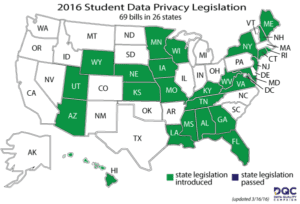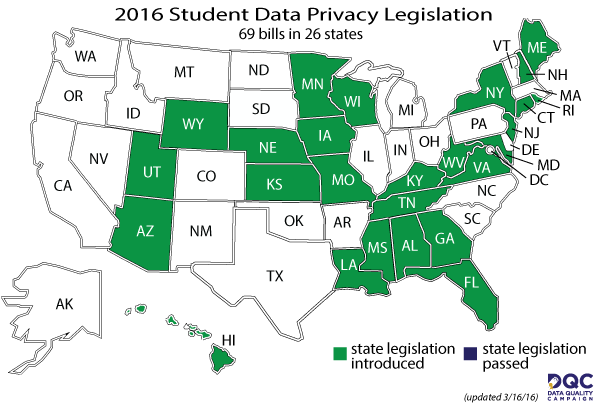March brings the promise of spring—and a chance to catch our breath and look at some of the themes emerging from states’ student data privacy legislation this year. After two years of legislating at breakneck speed (you may recall that in 2015 we saw a whopping 182 bills in 46 states), states this year are introducing fewer privacy bills: so far just 69 bills in 26 states. However, this year’s slowdown is not unexpected and certainly does not indicate that states are ready to check the box on privacy and never think about it again.
While there have been fewer bills introduced this year, the scope of the bills and the data they seek to govern are growing broader. States are still concentrating on core issues we’ve seen in years past: transparency about how data are used and protected, governance (or how to manage and make decisions about data), and the use of data by third party service providers. Eighteen bills have been introduced in 11 states modeled off of California’s Student Online Personal Information Protection Act (SOPIPA) law, which legislates third party vendors’ use of student data.
However, new issues, such as social media privacy in schools and the use of one-to-one devices, are emerging as well—and could have implications for the new accountability systems states must create under the Every Student Succeeds Act (ESSA). Several states this year have introduced legislation to limit or prohibit the collection of non-academic data by restricting the administration of nonacademic surveys, prohibiting assessments that collects nonacademic data, or defunding the state’s education data system (SLDS) if it includes any nonacademic data beyond what is required for administrative purposes. At the same time, ESSA now requires states to incorporate nonacademic indicators into their school accountability systems, potentially making the implications of this legislative trend complicated for ESSA implementation.
Over the last few years, it seems like states have been scrambling to build their privacy legislation plane as they were simultaneously attempting to fly it. But the slower-paced privacy environment that’s emerging in many states gives policymakers and education leaders a chance to focus on how to best implement their new laws and to distill some valuable lessons on legislating privacy. Together with ESSA’s new data transparency and use provisions, the more moderated pace of state legislation this year gives legislators an opportunity to reexamine how their state can best safeguard student privacy and use data to support student success.
Want to learn more about state legislative themes this year? Join us for a webinar on March 17 at 3:00 p.m. EDT.



